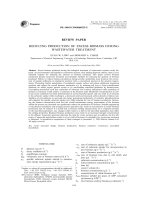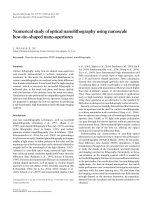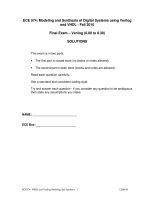High-temperature production of acerola vinegar using thermotolerant Acetobacter senegalensis A28
Bạn đang xem bản rút gọn của tài liệu. Xem và tải ngay bản đầy đủ của tài liệu tại đây (815.09 KB, 6 trang )
Physical sciences | Chemistry
High-temperature production of acerola vinegar
using thermotolerant Acetobacter senegalensis A28
Trinh Nguyet Tran, Huynh Xuan Phong, Bui Thi Thao Anh, Bui Hoang Dang Long,
Nguyen Ngoc Thanh, and Ngo Thi Phuong Dung*
Biotechnology Research and Development Institute, Can Tho University
Received 11 May 2018; accepted 4 September 2018
Abstract:
Introduction
Acerola (Malpighia emarginata) vinegar is one kind
of fruit vinegar produced using acetic acid fermented
by acetic acid bacteria. In this study, Acetobacter
senegalensis A28 was applied in acerola vinegar
production at a high temperature. With 1.0% (v/v) of
A. senegalensis A28 inoculum, the suitable conditions
for production of acerola vinegar were determined to
be pH 6.5, 20°Brix, 106 cells/ml, as well as 4.0% (v/v) of
ethanol added to acerola juice. Moreover, a temperature
of 35°C was found to be suitable for fermentation
in both 100 ml and 2 litre working volumes. Total
acid concentrations of 5.45% (w/v) and 4.90% (w/v),
respectively, were achieved after 4 days of fermentation.
Acid concentrations of 5.40% (w/v) and 4.70% (w/v)
were obtained at 37°C after 5 days of fermentation in
volumes of 100 ml and 2 litres, respectively. At pilot-scale
fermentation of 20 litres at 37°C, acid concentration of
3.68% (w/v) was achieved after 5 days of fermentation.
Fermentation products have been studied to improve
their quality, productivity, scale, and diversity to meet
consumers’ increasing demands. Today, such research
brings the possibility of the application of the results to
industrial production [1]. One of these products is vinegar, a
condiment that is indispensable in our daily diet; in addition,
it plays an important role in supporting and maintaining
human health. At present, many new types of vinegar are
being studied and put into trial production at low cost.
These are based on inexpensive and readily available raw
materials, compared to traditional rice vinegar, in order to
meet the current market’s demands. Among the variety of
methods of fermentation, sink methods are most commonly
used. Much research has been conducted to explore the
possibility of producing fruit vinegar from many sources,
such as pineapple peel [2]. Acetic acid bacteria (AAB),
one of the essential bacteria in vinegar fermentation, are
being studied by scientists (e.g. oxidation mechanisms of
ethanol to produce acetic acid, methods for identification,
etc.), and achieve a variety of applications in practice. Thus,
the process of vinegar fermentation is being optimised day
by day. They are very diverse in nature (appearing more
in fruits, grains, herbs, etc.) and are important in the food
industry for oxidizing sugar and wine into acetic acid [3,
4]. Therefore, AAB play an important role in the industrial
production of vinegar. In addition, they can be used in the
production of cellulose and sorbose [5]. Temperature is a
factor that plays an important role - it is the deciding factor
in vinegar fermentation. However, climate change which is
increasing global temperatures, is significant challenge for
the fermentation ability of AAB. The optimal temperature
for the fermentation of AAB is 28-30°C, and increased
temperature has a strong influence on the production of
vinegar [1, 6]. Therefore, today, the study of thermotolerant
Keywords: acerola, acetic acid bacteria, Acetobacter
senegalensis, fruit vinegar, thermotolerance.
Classification number: 2.2
*Corresponding author: Email:
September 2018 • Vol.60 Number 3
Vietnam Journal of Science,
Technology and Engineering
13
Physical Sciences | Chemistry
strains of AAB is an important consideration, not only for
scientists but also for producers. In addition, the application
of heat-resistant strains of AAB in large-scale industrial
manufacturing is widely studied at present.
The goal of this paper is twofold: to determine the
suitable proportion of ethanol to be added, and the favorable
pH value, °Brix, and cell density; and to study hightemperature vinegar fermentation from acerola at working
volumes of 2 litres and 20 litres.
Materials and methods
Culture and materials
Thermotolerant A. senegalensis A28 was isolated
from a rice wine starter, identified, and stored at the Food
Biotechnology Laboratory, Biotechnology Research and
Development Institute, Can Tho University. Acerola which
had ripened to a red colour was selected and purchased at
An Nghiep market, Ninh Kieu district, Can Tho, Vietnam.
Examination of the characteristics of A. senegalensis
A28
A. senegalensis A28 was cultured in yeast extractpeptone-glycerol-D_glucose (YPGD, yeast extract 5 g/l,
peptone 5 g/l, glycerol 5 g/l, D-glucose 5 g/l) agar and
broth for 24-48 hours at 35°C to observe the bacterial shape
and cells under the microscope. Gram stain, catalase, and
oxidase tests were conducted
Study of the suitable proportion of ethanol to be added
to the acerola juice
The experiment was designed according to completely
random design (CRD), with one factor, five levels
(proportion of ethanol added (4, 5, 6, 7, 8% v/v)) and three
replications. °Brix, pH, and cell density of the acerola juice
were adjusted based on the suitable conditions selected from
the previous section, and were supplied with a percentage
of ethanol as experimental design. The amount of acid, pH
value, and amount of total sugar were determined during 7
days of fermentation in aerobic conditions at 35°C.
Study of the suitable levels of ᴼBrix, pH, and cell
concentration for vinegar fermentation
The experiment was designed according to CRD, with
3 factors, 3 levels, and 3 replications: °Brix (15, 20, 25);
pH (3.5, 5, 6.5); cell concentration (103, 105, 107 cell/ml).
A. senegalensis A28 was cultured in a YPGD medium
for 48 hours at 30°C, and the acerola juice was diluted
14
Vietnam Journal of Science,
Technology and Engineering
with distillated water at a ratio of 1:4. °Brix, pH, and cell
density were adjusted according to the experimental design,
sterilised with NaHSO3 (140 mg/l), and supplied with 4%
(v/v) ethanol. The amount of acid amount, pH value, and
amount of total sugar were determined during 7 days of
fermentation in aerobic conditions at 35°C.
Study of vinegar fermentation with a working volume
of 100 ml
The experiment was designed according to CRD with
3 levels of temperature: 35°C, 37°C and 39°C, and 3
replications. °Brix, pH, cell density, and the percentage
of ethanol in the acerola juice were adjusted based on the
suitable conditions selected from the previous sections.
The prepared acerola juice with a volume of 100 ml was
incubated at 35°C, 37°C, and 39°C. The amount of acid, pH
value, and amount of total sugar were determined during 7
days of fermentation in aerobic conditions.
Study of vinegar fermentation with a working volume
of 2 litres
The experiment was designed according to CRD with
3 levels of temperature: 35°C, 37°C and 39°C, and 3
replications. °Brix, pH, cell density, and the percentage
of ethanol in the acerola juice were adjusted based on the
suitable conditions selected from the previous sections.
The prepared acerola juice with a volume of 2 litres was
incubated at 35°C, 37°C, and 39°C. The amount of acid, pH
value, and amount of total sugar were determined during 7
days of fermentation in aerobic conditions.
Study of vinegar fermentation with working volume of
20 litres
The experiment was designed according to CRD with 2
levels of temperature (37°C and 39°C) and 3 replications.
°Brix, pH, cell density, and the percentage of ethanol in the
acerola juice were adjusted based on the suitable conditions
selected from the previous sections. The prepared acerola
juice with a volume of 20 litres was incubated at 37°C and
39°C. The amount of acid, pH value, and amount of total
sugar were determined during 7 days of fermentation in
aerobic conditions.
Acerola vinegar products with the working volumes
of 2 litres and 20 litres underwent preliminary analysis
using quality indicators following Vietnam’s standard No.
3215:79. This included: sensory evaluation (colour, odour,
and clarity) by 10 people, as well as pH, ����������������������������������������������������������������������������������������������������������������������������������������������������������������������������������������������������������������������������������������������������������������������������������������������������������������������������������������������������������������������������������������������������������������������������������������������������������������������������������������������������������������������������������������������������������������������������������������������������������������������������������������������������������������������������������������������������������������������������������������������������������������������������������������������������������������������������������������������������������������������������������������������������������������������������������������������������������������������������������������������������������������������������������������������������������������������������������������������������������������������������������������������������������������������������������������������������������������������������������������������������������������������������������������������������������������������������������������������������������������������������������������������������������������������������������������������������������������������������������������������������������������������������������������������������������������������������������������������������������������������������������������������������������������������������������������������������������������������������������������������������������������������������������������������������������������������������������������������������������������������������������������������������������������������������������������������������������������������������������������������������������������������������������������������������������������������������������������������������������������������������������������������������������������������������������������������������������������������������������������������������������������������������������������������������������������������������������������������������������������������������������������������������������������������������������������������������������������������������������������������������������������������������������������������������������������������������������������������������������������������������������������������������������������������������������������������������������������������������������������������������������������������������������������������������������������������������������������������������������������������������������������������������������������������������������������������������������������������������������������������������������������������������������������������������������������������������������������������������������������������������������������������������������������������������������������������������������������������������������������������������������������������������������������������������������������������������������������������������������������������������������������������������������������������������������������������������������������������������������������������������������������������������������������������������������������������������������������������������������������������������������������������������������������������������������������������������������������������������������������������������������������������������������������������������������������������������������������������������������������������������������������������������������������������������������������������������������������������������������������������������������������������������������������������������������������������������������������������������������������������������������������������������������������������������������������������������������������������������������������������������������������Y
Here,
is the concentration
sugarsY and
cell
obtained after solving
theXequation
X = 20.26 of°Brix,
= 10Y6 iscells/ml.
As a res
0.0316667×Y×6.5+0.0488889×6.5×6.5-0.0005×X×Y×6.5
density. The results were obtained after solving the equation
optimal condition for fermentation was determined as 20.26 °Brix (concentra
Fig. 1. Total acid production by A. senegalensis A28 at different
sugars), initial
ethanol concentrations.
X=20.26°Brix, Y=106 cells/ml. As a result, the optimal
pH
6.5, and
106 cells/mlwas(cell
density).as The
highest amount o
condition
for fermentation
20.26°Brix
Here,
X
is
the
concentration
of sugars determined
andthe
Y pHis cell
density.
The results
produced was 5.88%
(w/v).
After
fermentation,
values
were
reduced.
Ho
6
cells/
(concentration
of
sugars),
initial
pH
6.5,
and
10
6
In almost all the treatments, the amount of acid produced
cells/ml.
resulad
obtained inafter
solving
thecan
equation
= conditions
20.26amount
°Brix,ranging
Y acid
= 10from
thermotolerant
grow The
inXpH
3.0 toAs
7.7.a In
ml (cell
density).
highest
of
produced
the bacteria
increased from the 1st day to the 4th day and decreased
the
optimal
fermentation
conditions
for
acerola
vinegar
in20.26
this
experiment
were sim
wasfor5.88%
(w/v). After
theaspH
values
were (concentratio
last 3 days, especially, the treatment that had
4%
ethanol
optimal
condition
fermentation
wasfermentation,
determined
°Brix
reduced.
However,
in acetic acid
added. Following 7 days of fermentation, A.
thesenegalensis
conditions for
the fermentation
of banana bacteria
vinegar:can
thegrow
highest
6 thermotolerant
sugars),
initial
pH
6.5,
and
10
cells/ml
(cell
density).
The
highest
amountcon
of
A28 in the acerola juice containing 4%obtained
(v/v) ethanol
pH
conditions
ranging
from
3.0
to
7.7.
In
addition,
the
was 4% (v/v) after 6 weeks of fermentation at 37-38°C in a medium
produced
5.88%
Aftersugars,
fermentation,
the pH [8].
values were reduced. How
5%
ethanolwas
(v/v),
20.62(w/v).
g/l used
and 105 cells/ml
thermotolerant
bacteria can atgrow
in pH
conditions
3.0 tovolume
7.7. Inofadd
Vinegar fermentation
35°C,
37°C,
and 39°Cranging
with afrom
working
10
Vietnam Journal of Science,
September 2018 • Vol.60 Number 3
15
Technology
and Engineering
the optimal
fermentation
conditionswithforA.acerola
vinegar
in thisinexperiment
were simi
The results
of fermentation
senegalensis
A28
100 ml of prepared
juice
are presented
3. The amount
of total acid
of treatments
incubated
the conditions
for intheFig.fermentation
of banana
vinegar:
the highest
acetic atacid35
Physical Sciences | Chemistry
optimal fermentation conditions for acerola vinegar in
this experiment were similar to the conditions for the
fermentation of banana vinegar: the highest acetic acid level
obtained was 4% (v/v) after 6 weeks of fermentation at 3738°C in a medium containing 5% ethanol (v/v), 20.62 g/l
used sugars, and 105 cells/ml [8].
Vinegar fermentation at 35°C, 37°C, and 39°C with a
working volume of 100 ml
The results of fermentation with A. senegalensis A28
in 100 ml of prepared acerola juice are presented in Fig.
3. The amount of total acid of treatments incubated at
35°C and 37°C was much higher than others. Indeed, A.
senegalensis A28 incubated at 35°C produced the largest
amount of acid on the 4th day of fermentation (5.45%
w/v); while for the incubation of bacteria at 37°C, the
highest amount of acid produced 5.4% (w/v) on the 5th day
because when incubating at 37°C, bacteria need more time
for their development and growth. In order to save both
time for fermentation costs of production for treatment at
35°C, day 4 was selected, as the amount of acid produced
then was greater than on the other days. Moreover, the pH
value after 7 days of fermentation decreased considerably
compared to the initial values (3.19 for the 37°C treatment,
and 3.68 for the 35°C treatment). The amount of sugar
used for treatments incubated at 35°C and 39°C was very
low (11.37 g/l and 14.31 g/l, respectively). In comparison,
2.52% (w/v) of acid was achieved from A. tropicalis DK4
after 7 days of fermentation in YPGD containing 4% (v/v)
ethanol at 39°C. That is, the amount of acid produced in
this study was much higher [9]. This research shows that
the fermentation capacity of A. senegalensis at three levels
of temperatures, 35°C, 37°C, and 39°C. 35°C was the most
suitable temperature for the fermentation of acerola juice.
Fig. 3. Total acid production by A. senegalensis A28 at a working
volume of 100 ml.
16
Vietnam Journal of Science,
Technology and Engineering
Vinegar fermentation at 35°C, 37°C, and 39°C at a
working volume of 2 litres
The fermentation results of A. senegalensis A28 in 2
litres at 35°C, 37°C, and 39°C over 7 days are presented in
Fig. 4. The amount of acid for treatment at 35°C was always
higher than two other treatments during fermentation, and,
at 35°C, the highest amount of acid was produced on the
4th day (4.9% w/v). However, the amount acid produced in
the two treatments at 37°C and 39°C increased from day 1
to day 5 and decreased over the last two days because the
bacteria needed time for development and growth. Thus, as
with the above experiment, the amount of acid on the 4th
day was selected. Moreover, on the 5th day of fermentation,
the amount of acid produced was 4.7% (w/v). Subsequently,
the range of pH values at the three levels of temperature was
3.58 to 4.01 over 7 days of fermentation. With treatment
at 35°C, the amount of sugar used by the bacteria was the
lowest (9.9 g/l). In addition, the most suitable temperature
for A. senegalensis A28 was 28°C [7]. Previous works show
that when the temperature increases, the amount of acid
produced decreases [1, 10]. Thus, we see that at 35°C, the
amount of acid produced was the largest; it decreased when
temperature was increased to 37°C and 39°C. In conclusion,
experiment shows the fermentation capacity of bacteria
at temperatures of 35°C, 37°C, and 39°C at the working
volume of two litres.
According to the experiments at the working volume of
100 ml and 2 litres, 35°C was the suitable temperature level
for fermentating with acerola juice and A. senegalensis A28.
However, at 37°C and 39°C, this strain also demonstrated
good fermentation capacity and good ability for growth. The
purpose of these experiments was to test the fermentation
ability of A. senegalensis A28 at high temperatures; hence,
these two temperatures were selected for fermentation at a
larger scale.
Fig. 4. Total acid production by A. senegalensis A28 at a working
volume of 2 litres.
September 2018 • Vol.60 Number 3
Physical sciences | Chemistry
Vinegar fermentation at 37ᴼC and 39ᴼC at a working
volume of 20 litres
A. senegalensis A28 was fermented with 20 litres of
prepared acerola juice, and incubated at 37°C and 39°C in
aerobic conditions for 7 days. The results are presented in
Fig. 5. Over 7 days of fermentation, A. senegalensis A28
produced a higher amount of acid when incubated at a
working volume of 20 litres at 37°C (3.68% (w/v) on day
5) in comparison to incubation at 39°C. The amount of acid
increased from the 1st day to the 5th day, and decreased over
the last 2 days; thus, on days 6 and 7, the amounts of ethanol
and sugar were not enough for the bacteria to use for growth
and to produce acid.
people was undertaken, as was analysis of pH, the amount
of acid, and the amount of retentive ethanol. The results
of physical and chemical indicators show that the pH and
the amount of acid produced correlate with each other.
The highest amount of acid produced in five treatments
was 5.9% (w/v). The amount of acid in the vinegar was
equivalent to that of some vinegar products in supermarkets,
such as apple vinegar, rice fermented vinegar, and the like
(approximately 4-7% acid, depending on the products).
In addition, the amount of retentive ethanol in the acerola
vinegar products was very low (the largest was 0.032%);
thus, it would not affect consumers’ health. The results of
the sensory evaluation following TCVN 3215:79 in almost
all treatments showed a general score that was higher
than 15.2. This means that acerola vinegar products were
evaluated as being of ‘moderately good’ quality. However,
treatment at 39°C at a working volume of 2 litres obtained
a score of 13.0, that is, a ‘medium’ standard of quality.
Moreover, acerola vinegar products that were incubated at
37°C at working volumes of 2 litres and 20 litres attained
higher scores than the others.
Conclusions
Fig. 5. Total acid production by A. senegalensis A28 at a working
volume of 20 litres.
At the two levels of temperature, the highest amount of
acid was produced on the 5th day of fermentation, so day
5 was selected. The pH value of acerola juice declined
dramatically compared to what it had been initially (both
3.52 for the two treatments on the final day). as the amount
of sugar used by the bacteria with treatment at 37°C was
lower (7.79 g/l). This experiment illustrates that at 37°C,
A. senegalensis A28 has better fermentation capacity. In
comparison with the working volume of 100 ml and 2 litres,
the amount of acid produced with the working volume of
20 liters was continuously lower because of the aerobic
condition for the fermentation of acetic acid bacteria [11].
Indeed, when bacteria were incubated at larger scale,
the surface that was in contact with the atmosphere was
decreased, leading to a decline in the amount of acid.
In addition, for acerola vinegar products at a working
volume of 2 litres and 20 litres, sensory evaluation by 10
The addition of 4% (v/v) ethanol to acerola juice (pH 6.5,
20°Brix), initial bacterial cell density of 106 cells/ml, and a
fermentation temperature of 35°C are suitable conditions
for acerola vinegar fermentation using A. senegalensis
A28. The amounts of acid at 5.45% (w/v) and 4.90% (w/v)
were achieved at working volumes of 100 ml and 2 litres,
respectively, after 4 days of fermentation. The amount of
acid at a working volume of 100 ml was 5.4% (w/v) and at
a working volume of 2 litres was 4.7% (w/v). The acerola
juice was fermented for 5 days at 37°C. At a working volume
of 20 litres, the highest amount of acid was 3.68% (w/v)
when incubated for 5 days at 37°C. In addition, evaluation
of organoleptic, physical, and chemical indicators illustrate
that treatment at 37°C produced a delicious product that is
suitable for the tastes of consumers.
ACKNOWLEDGEMENTS
This research was jointly supported by the Ministry of
Science and Technology of Vietnam (contract Nr. 09/2014/
HĐ-NĐT); the Advanced Programme in Biotechnology,
Can Tho University; and the New Core-to-Core
Programme (2014-2019). We would like to thank Prof.
Dr Kazunobu Matsushita and Assoc. Prof. Dr Toshiharu
Yakushi (Department of Biological Chemistry, Yamaguchi
University) for their support and guidance with acetic acid
bacteria identification under the JSPS and SSSV exchange
research at Yamaguchi University, Japan.
September 2018 • Vol.60 Number 3
Vietnam Journal of Science,
Technology and Engineering
17
Physical Sciences | Chemistry
REFERENCES
[1] A. Saeki, G. Theeragool, K. Matsushita, H. Toyama, N. Lotong,
and O. Adachi (1997), “Development of thermotolerant acetic acid
bacteria useful for vinegar fermentation at high temperatures”, Biosci.
Biotechnol. Biochem., 61(1), pp.138-145.
[2] O.R. Yusuf, M. Jibril, I.M. Misau, and Y.D. Baba (2012),
“Production of vinegar from pineapple peel”, Int. J. Adv. Sci. Res.
Tech., 2(3), pp.4-11.
[3] A. Moryadee and P. Wasu (2008), “Isolation of thermotolerant
acetic acid bacteria from fruits for vinegar production”, Res. J.
Microbiol., 3(3), pp.209-212.
[4] W. Pathom-aree (2009), “Isolation of acetic acid bacteria from
honey”, Maejo Int. J. Sci. Tech., 3(1), pp.71-76.
[5] I.Y. Sengun and S. Karabiyikli (2011), “Importance of acetic
acid bacteria in food industry”, Food Control, 22(5), pp.647-656.
[6] D. Moonmangmee, O. Adachi, Y. Ano, E. Shinagawa, H.
Toyama, G. Theeragool, N. Lotong, and K. Matsushita (2000),
“Isolation and characterization of thermotolerant Gluconobacter
strains catalyzing oxidative fermentation at higher temperatures”,
Biosci. Biotechnol. Biochem., 64(11), pp.2306-2315.
18
Vietnam Journal of Science,
Technology and Engineering
[7] B. Ndoye, I. Cleenwerck, K. Engelbeen, R. Dubois-Dauphin,
A.T. Guiro, S. Van Trappen, A. Willems, and P. Thonart (2007),
“Acetobacter senegalensis sp. nov., a thermotolerant acetic acid
bacterium isolated in Senegal (sub-Saharan Africa) from mango fruit
(Mangifera indica L.)”, Int. J. Syst. Evol. Microbiol., 57(7), pp.15761581.
[8] N.T.M. Hien and N.M. Thuy (2014), “Correlation between
the amount of produced acid, ethanol, sugar and Acetobacter aceti
concentration in the production of banana vinegar”, Can Tho Univ. J.
Sci., 1, pp.76-83.
[9] H. X. Phong (2011), Isolation and characterization of
thermotolerant acetic acid bacteria, Master thesis, Can Tho
University, Vietnam.
[10] W. Kanchanarach, G. Theeragool, T. Yakushi, H. Toyama,
A. Adachi, and K. Matsushita (2010), “Characterization of
thermotolerant Acetobacter pasteurianus strains and quinoprotein
alcohol dehydrogenases”, Appl. Microbiol. Biotechnol., 85(3),
pp.741-751.
[11] D. Mamlouk and M. Gullo (2013), “Acetic acid bacteria:
physiology and carbon sources oxidation”, Indian J. Microbiol.,
53(4), pp.377-384.
September 2018 • Vol.60 Number 3









